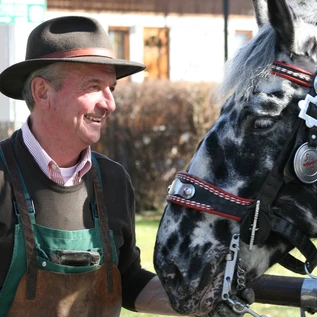Visit us at
The Stiftsarmstollen at the Almkanal | © Christian Klotz
City feeling
The Almkanal and The Big Clean-Up
When German-speakers hear the word “Alm”, it immediately conjures up images of contented cows grazing on green alpine meadows in summertime and cheerful people, often sporting traditional folk costumes, gathered outside rustic mountain huts, taking in the views and soaking up the sunshine. Which raises the question as to why that same word is applied to a stream that runs right through the heart of a world-famous city like Salzburg.
Admittedly, ruminating cows and gently tolling bells dangling from around their necks are nowhere to be seen in downtown Salzburg. But what you do encounter is a powerful little stream – or actually a manmade canal, to be precise – known as the Almkanal. With the exception of a three-week period every year, that is, when the city “turns off” the water, temporarily houses the fish in containers, and along come a handful of men equipped with rubber boots, rakes and nets instead.
Living Piece of City History
The Almkanal generally surges along out of eyeshot. Underground, that is. Its source is the Königssee Ache in Berchtesgaden, and it generally makes itself known by the constant-yet-invisible rushing sound it produces. Salzburg visitors are quickly initiated into a conundrum that even baffles locals from time to time: “How do I find the Almkanal?” On its cleverly plotted course through the city, it actually pours into the River Salzach at seven different locations. If you want to catch a glimpse of it, you’d best head to the grain mill at St. Peter’s, or to Universitätsplatz Square: There, the water thunders along at high velocity and can briefly be glimpsed above ground – as has been the case since the 12th century! Back then, St. Peter’s Abbey and the Salzburg Archdiocese, who were by far the biggest and most influential land owners of the day, decided to cut a pathway for the water to flow through the Mönchsberg, water which could then be used for agricultural purposes. This tunnel became known as the “Stiftsarmstollen”. Today, the Almkanal doesn’t only power a number of small power stations, it also serves as the air-conditioning system for Salzburg’s Festspielhaus, well familiar to guests attending the city’s world-famous festival.
Cleaning crew, you’re up!
Every year in September, it’s that time again: The sluice gate from the Königssee Ache is closed and the water level in the Almkanal drops to a minimum. This marks the start of three exciting work-packed weeks. But before they can get on with the cleaning, job one is to rescue the fish. Most of them are brook trout, kept safe in big containers and fed with an ample supply of oxygen until they can be released back into the Königssee Ache. At that point, the workers enter the empty canal, removing as much mud and accumulated trash as possible, allowing the actual repair and renovation work to get underway. In the process, the rather unconventional cleaning crew comes across all kinds of curious objects: traffic signs, bikes and even, they claim, a real-life safe!
Salzburg’s Underworld
Those same three weeks also represent an exciting window for adventurous locals and tourists, who are able to hike through the Stiftsarmstollen on guided tours. Led by experts, they forge 400 meters deep inside the Mönchsberg, through a tunnel measuring 2.20 meters at its highest point. Needless to say, rubber boots are highly recommended for this expedition. The ground isn’t only dotted with puddles, by the way. It is also plastered in places by marble slabs; some of which originated from the abandoned cathedral cemetery. The various forms of construction are mainly the result of tunnel cave-ins that occurred over the centuries. That said, you will come across alternating examples of pointed and rounded vaults as well as stone cladding.
So, returning to our opening comments: Why did they go with the name “Almkanal”, when the canal clearly has nothing to do with those idyllic alpine pastures we mentioned before? In fact, the answer is quite simple. The Königssee Ache is known locally as the “Alm” or “Albe”, which in this instance means “white”, a reference to the fact that the river fills with water from the snowmelt.














